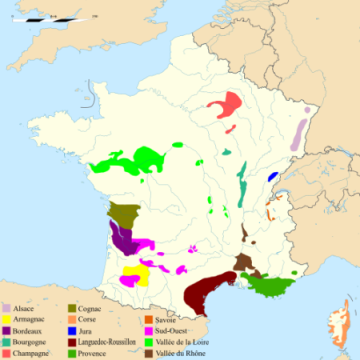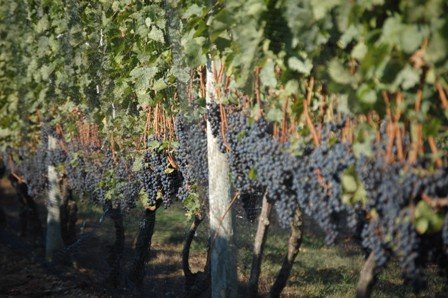|
French red wine, Old world welcome to my world,
French Red Wine go to: French Red Wine French red wine is produced in several regions throughout France. France has the world's second-largest total vineyard area, behind Spain, and competes with Italy for the position of being the world's largest wine producer. French wines accounted for 17.6% of world exports in 2005. It hold about 45% imported wine market share in countries like India. French wine traces its history to the 6th century BC, with many of France's regions dating their wine-making history to Roman times. The wines produced today range from expensive high-end wines sold internationally, to more modest wines usually only seen within France. Two concepts central to higher end French wines are the notion of "terroir", which links the style of the wines to the specific locations where the grapes are grown and the wine is made, and the Appellation d'Origine Contrôlée (AOC) system. Appellation rules closely define which grape varieties and winemaking practices are allowed in each of France's several hundred geographically defined appellations, which can cover entire regions, individual villages or even specific vineyards. France is the source of many grape varieties (such as Cabernet Sauvignon, Chardonnay, Pinot Noir, Sauvignon Blanc, and Syrah) that are now planted throughout the world, as well as wine-making practices and styles of wine that have been adopted in other producing countries. Although some producers have benefited in recent years from rising prices and increased demand for some of the prestige wines from Burgundy and Bordeaux, the French wine industry as a whole has been influenced by a decline in domestic consumption as well as growing competition from both the New World and other European countries. 
French wine originated in the 6th century BC, with the colonization of Southern Gaul by Greek settlers. Viticulture soon flourished with the founding of the Greek colony of Marseille. The Roman Empire licensed regions in the south to produce wines. St. Martin of Tours (316-397) was actively engaged in both spreading Christianity and planting vineyards. During the Middle Ages, monks maintained vineyards and, more importantly, conserved wine-making knowledge and skills during that often turbulent period. Monasteries had the resources, security, and motivation to produce a steady supply of wine both for celebrating mass and generating income. During this time, the best vineyards were owned by the monasteries and their wine was considered to be superior. Over time the nobility developed extensive vineyards. However, the French Revolution led to the confiscation of many of the vineyards owned by the Church and others. The advance of the French wine industry stopped abruptly as first Mildew and then Phylloxera spread throughout the country, indeed across all of Europe, leaving vineyards desolate. Then came an economic downturn in Europe followed by two world wars, and the French wine industry didn't fully recover for decades. Meanwhile competition had arrived and threatened the treasured French "brands" such as Champagne and Bordeaux. This resulted in the establishment in 1935 of the Appellation d'Origine Contrôlée to protect French interests. Large investments, the economic upturn following World War 2 and a new generation of Vignerons yielded results in the 1970s and the following decades, creating the modern French wines we know today.

The recognized wine producing areas in France are regulated by the Institut National des Appellations d'Origine - INAO in acronym. Every appellation in France is defined by INAO, in regards to the individual regions particular wine "character". If a wine fails to meet the INAO's strict criteria it is declassified into a lower appellation or even into Vin de Pays or Vin de Table. With the number of appellations in France too numerous to mention here, they are easily defined into one of the main wine producing regions listed below: Alsace Alsace is primarily a white-wine region, though some red, rosé, sparkling and sweet wines are also produced. It is situated in eastern France on the river Rhine and borders Germany, a country with which it shares many grape varieties as well as a long tradition of varietal labeling. Grapes grown in Alsace include Riesling, Gewurztraminer, Pinot Gris, Pinot Blanc, Pinot Noir, and Muscat. Bordeaux Bordeaux is a large region on the Atlantic coast, which has a long history of exporting its wines overseas. This is primarily a red wine region, famous for the wines Château Lafite-Rothschild, Château Latour, Château Mouton-Rothschild, Château Margaux and Château Haut-Brion from the Médoc sub-region; Château Cheval Blanc and Château Ausone in Saint-Émilion; and Château Pétrus and Château Le Pin in Pomerol. The red wines produced are usually blended, from Cabernet Sauvignon, Merlot and sometimes Cabernet Franc. Bordeaux also makes dry and sweet white wines, including some of the world's most famous sweet wines from the Sauternes appellation, such as Château d'Yquem. Burgundy Burgundy or Bourgogne in eastern France is a region where red and white wines are equally important. Probably more terroir-conscious than any other region, Burgundy is divided into the largest number of appellations of any French region. The top wines from Burgundy's heartland in Côte d'Or command high prices. The Burgundy region is divided in four main parts:
The Cote de Nuits (from Marsannay-La-Cote down to Nuits-Saint-Georges) The Cote de Beaune (from north of Beaune to Santenay) The Cote Chalonnaise The Maconnais Two parts of Burgundy that are sometimes considered as separate regions are: Beaujolais in the south, close to the Rhône Valley region, where mostly red wines are made in a fruity style that is usually consumed young. "Beaujolais Nouveau" is the only wine that can be legally consumed in the year of its production (Third week end of November)Chablis halfway between Côte d'Or and Paris, where white wines are produced on chalky soil giving a more crisp and steely style than the rest of Burgundy.There are two main grape varieties used in Burgundy - Chardonnay for white wines, and Pinot Noir for red. White wines are also sometimes made from Aligoté, and other grape varieties will also be found occasionally. Champagne Champagne, situated in eastern France, close to Belgium and Luxembourg, is the coldest of France's major wine regions and home to its major sparkling wine. Champagne wines can be both white and rosé. A small amount of still wine is produced in Champagne (as AOC Coteaux Champenois) of which some can be red wine.Corsica Corsica is an island in the Mediterranean the wines of which are primarily consumed on the island itself. It has nine AOC regions and an island-wide vin de pays designation and is still developing its production methods as well as its regional style. Jura Jura, a small region in the mountains close to Switzerland where some unique wine styles, notably Vin Jaune and Vin de Paille, are produced. The region covers six appellations and is related to Burgundy through its extensive use of the burgundian grapes Chardonnay and Pinot Noir, though other varieties are used. It also shares cool climate with Burgundy. Languedoc-Roussillon Languedoc-Roussillon is the largest region in terms of vineyard surface, and the region in which much of France's cheap bulk wines have been produced. While still the source of much of France's and Europe's overproduction, the so-called "wine lake", Languedoc-Roussillon is also the home of some innovative producers who combine traditional French wine and international styles while using lessons from the New World. Much Languedoc-Roussillon wine is sold as Vin de Pays d'Oc.
Loire Loire valley is a primarily white-wine region that stretches over a long distance along the Loire River in central and western France, and where grape varieties and wine styles vary along the river. Four subregions are situated along the river:
Upper Loire is known for its Sauvignon Blanc, producing wines such as Sancerre AOC, but also consisting of several VDQS areas;Touraine produces cold climate-styled white wines (dry, sweet or sparkling) from Chenin Blanc in Vouvray AOC and red wines from Cabernet Franc in Bourgueil AOC and Chinon AOC;Anjou-Saumur is similar to the Tourain wines with respect to varieties, but the dry Savennières AOC and sweet Coteaux du Layon AOC are often more powerful than their upstream neighbours. Saumur AOC and Saumur-Champigny AOC provides reds; andPays Nantais is situated closest to the Atlantic, and Muscadet AOC produces white wines from the Melon de Bourgogne grape.Provence Provence, in the southeast and close to the Mediterranean. It is perhaps the warmest wine region of France and produces mainly rosé and red wine. It covers eight major appellations led by the Provence flagship, Bandol. Some Provence wine can be compared with the Southern Rhône wines as they share both grapes and, to some degree, style and climate. Provence also has a classification of its most prestigious estates, much like Bordeaux. Rhône Rhone Valley, primarily a red-wine region in southeastern France, along the Rhône River. The styles and varietal composition of northern and southern Rhône differ, but both parts compete with Bordeaux as traditional producers of red wines. Savoy Savoy or Savoie, primarily a white-wine region in the Alps close to Switzerland, where many grapes unique to this region are cultivated. South West France South West France or Sud-Ouest, a somewhat heterogeneous collection of wine areas inland or south of Bordeaux. Some areas produce primarily red wines in a style reminiscent of red Bordeaux, while other produce dry or sweet white wines. There are also several smaller production areas situated outside these major regions. Many of those are VDQS wines, and some, particularly those in more northern locations, are remnants of production areas that were once larger.
Numerous grape varieties are cultivated in France, including both internationally well-known and obscure local varieties. In fact, most of the so-called "international varieties" are of French origin, or became known and spread because of their cultivation in France. Since French appellation rules generally restrict wines from each region, district or appellation to a small number of allowed grape varieties, there are in principle no varieties that are commonly planted throughout all of France. Most varieties of grape are primarily associated with a certain region, such as Cabernet Sauvignon in Bordeaux and Syrah in Rhône, although there are some varieties that are found in two or more regions, such as Chardonnay in Bourgogne (including Chablis) and Champagne, and Sauvignon Blanc in Loire and Bordeaux. As an example of the rules, although climatic conditions would appear to be favorable, no Cabernet Sauvignon wines are produced in Rhône, Riesling wines in Loire, or Chardonnay wines in Bordeaux. (If such wines were produced, they would have to be declassified to Vin de Pays or French table wine. They would not be allowed to display any appellation name or even region of origin.) Traditionally, many French wines have been blended from several grape varieties. Varietal white wines have been, and are still, more common than varietal red wines. French red wines are grown in greater quantities almost two to one over the white varieties.
Thank you Wikipedia for the information on this page Return from French Red Wine to Cheap Red Wine
|
Sign up for weekly Red Wine Reviews
CLICK HEREWe will send you the extremely popular Red-Wine-Home tasting terms when you sign-up.





